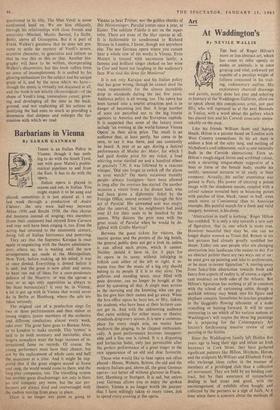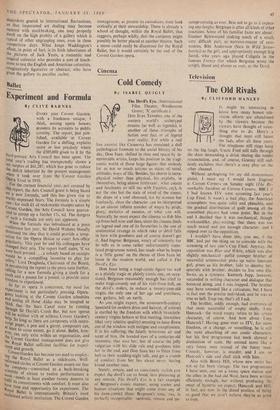Art
At Waddington's
By NEVILE WALLIS Like his friends William Scott and Adrian Heath, Hilton is a painter based on London with West Country connections. In his art there is seldom a hint of the salty tang, and nothing of Nicholson's cool refinement, such as one naturally finds in the Cornish abstractions. Even so, Hilton's rough-edged forms and scribbled colour, with a recurring tongue-shape suggestive of a boat or form of the female body, enable his untidy, sensuous pictures to sit easily in their company. Actually, this earlier experience was gained in Paris. His power of creating a Potent image with the slenderest means, coupled with a colour science revealed here in bouncing games with patches of blue, black, russet or buff, owes much more to Continental than to American example. His painful search for a fresh and valid imagery, however, is his alone.
'Abstraction in itself is nothing,' Roger Hilton has confided. 'It is only a step towards a new sort of figuration, that is, one which is more true. However beautiful they may be, one can no longer depict women as Titian did. Renoir in his last pictures had already greatly modified her shape. Today one sees people who are changing abstraction into landscape (the easiest to do). For an abstract painter there are two ways out or on: he must give up painting and take to architecture, or he must re-invent figuration.' A Veering-avvay from fancy-free abstraction towards fresh and fancy-free aspects of reality is, of course, a signifi- cant tendency on both sides of the Atlantic. But Hilton's figuration has nothing at all in common with the school of cartooning satire, though a quirkish whimsy may break into his figure and elephant conceits. Sometimes he touches grandeur in the sluggishly flowing silhouette of a nude crouching or leaning forward. It will be most interesting to see which of his various notions at Waddington's will inspire the three big paintings he is preparing for the Contemporary Art ' Society's forthcoming massive review of our painting in the Sixties.
Since the Waddington family left Dublin five years ago to hang their sign and infuse an Irish buoyancy in Cork Street, they have gathered significant painters like Hilton, Hitchens, Heron, and the sculptors Mc William and Elisabeth Frink, who exchange ideas rather in the manner of members of a privileged club than a collective art movement. They are held by no binding con- tract, but by their assurance of sympathetic dealing in bad times and good, with the encouragement of exhibits often bought and collected by the partners as a sign of faith. At a time when there is concern about the methods of
dealerdom geared to international fluctuations, SO that impersonal art dealing may become equated with stockbroking, one may properly dwell on the high probity of a gallery which is tYPical of other ungrasping ones, even in these competitive days. What keeps Waddington's afloat, in point of fact, is its Irish inheritance of the pictures of Jack Yeats, a romantic and magical colourist who provides a sort of touch- stone to test the English and American colourists, ,Ithaginatively figurative or abstract, who have Blven the gallery its peculiar cachet.































 Previous page
Previous page